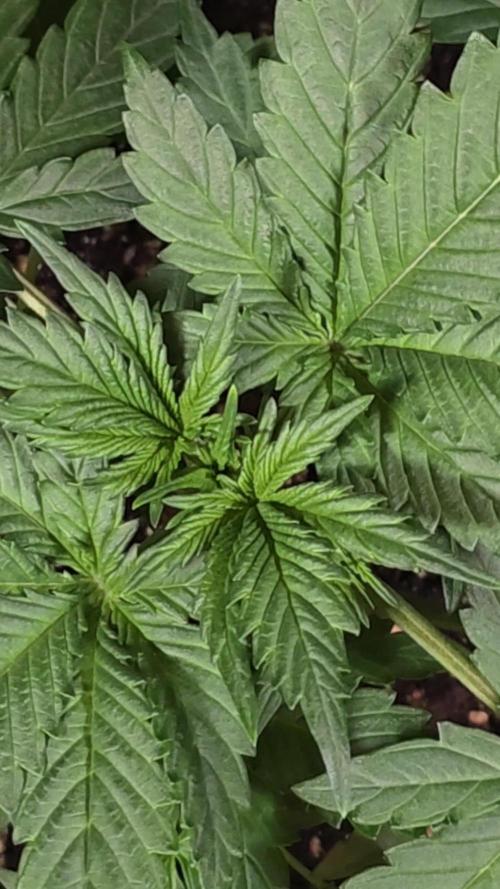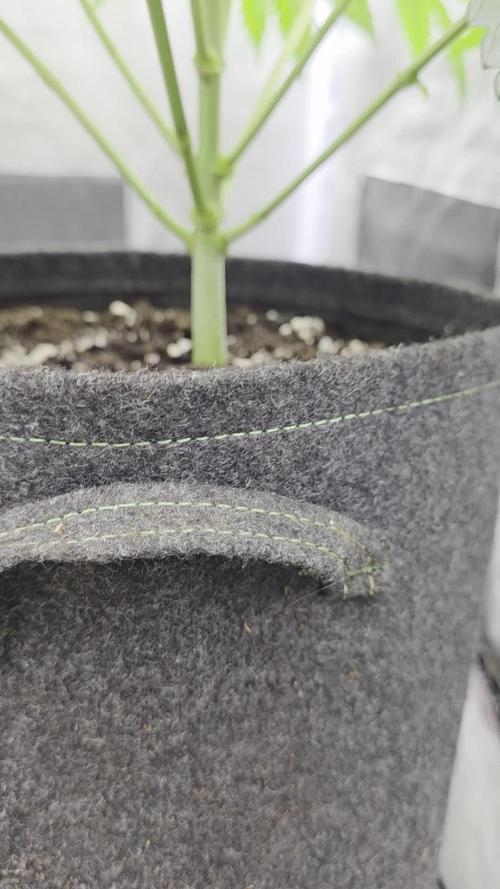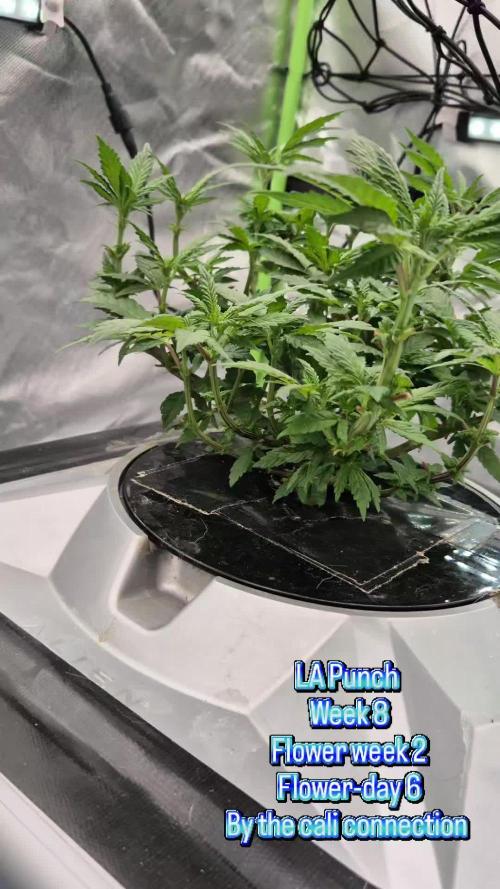The Grow Awards 2026 🏆 





























Likes
Comments
Share


@Natrona
Follow
Fat Bastard Auto by MSNL
👉Sponsored Grow👈
W2 V2
Fat Bastard shot up 4 inches this week and is now 6 inches tall now. Because I have iridium and copper in the water, the ph meter fluctuates due to breaking bonds between the hydrogen and oxygen. The fluctuation range I see is between 6.4 and 6.9 so I’m reporting 6.6. So far, I don’t see any negative effects of the iridium & copper on the plant.
The soil base is Happy frog, Coast of Maine, Mushroom Compost and super soil. I’m giving only ph water to her for this grow. I gave 1 liter of ph 6.6 PPM 376 at 66.7f twice this week
As always, thank you all for stopping by, for the likes and most of all growers’ love and support.
Stay green, growers love 💚🌿
💫Natrona💫
Likes
16
Share


@DeepRootsGrowTrees
Follow
GORILLA MELON / 420FASTBUDS
WEEK #13 OVERALL
Week #3 FLOWER
This week she doing good 👍 she's continued to grow her buds and she's getting good trichome coverage she's looking frosty. Stay Growing!!
Thank you for stopping by and taking a look it's much appreciated!!
BUDTRAINER.COM
BUD CLIPS/BUD CUPS
GORILLA MELON / 420FASTBUDS
Likes
16
Share


@GreeneScene
Follow
I stressed this lady out early accidentally , she bounced back as best as I permitted room for . She bared with me all the way until the end throughout this entire learning cycle . I’m deeply appreciative for the ease of grow & level of bounce back she had . It was the most impressive grow but it didn’t require rocket science to grow this either
Likes
23
Share


@Wazowskid
Follow
Looking good so far with a 10€ Amazon full spectrum light and the cheapest soil I could get from Lidl. I'm using a closet wrapped with aluminium foil as grow tent.
Likes
11
Share


@RoyColt
Follow
Day45 continue main lining,lst and def.
Day46
2,5lt ro water
2,5ml sensi cal mag extra
Total 200 ppm pH6.2
Drain 150 ml 880 ppm.
Day49 18.01
3lt ro water
4ml growA
4ml growB
total 1050 ppm ph 6,1
Drain 200ml 1080ppm.
Likes
24
Share


@EBxAH
Follow
Hey there everyone! Today the reapers are 33 days old!!! I love cultivating peppers! Everything is going GREAT so far!!! Today was their first day outside and they are LOVING it! Again, it's peppers so this will be a long journey, lol. I'm thinking about doing some clones though. Well, that's about it for now. Thanks for stopping by and Happy Growing Everyone
✌️❤️😁🍀🎶👽
EB
Likes
1
Share


@CheeRz
Follow
We flipped the switch and changed the light cycle to 12 hours. Both lemon ladies are doing pretty well, as is the development. Let's hope for a big harvest!
Likes
3
Share


@KcKush
Follow
*Increaded PPM to 650
*Last plant showed sex it’s s Female. Looked like a male almost chopped it.
*We Can say we got a 60% female return.
*These are ready to flower but need to take clones first.
Processing
Likes
8
Share


@Spgrows
Follow
Black cream has started to flower also old amazon light blew gave me excuse to buy a better one
Likes
17
Share


@OrganicBuds030
Follow
Mir gefällt Melonade Runtz bis jetzt sehr gut. Sie hat einen schnellen Wachstum und macht den Anschein als würde sie dicke fette Buds produzieren. Ich bin sehr gespannt wie dieser Run wird. Bis jetzt hatte keine Pflanze irgendwelche Mangelerscheinungen. Stabile Genetik von Dutch Passion 💚
Likes
7
Share


@RBG
Follow
Week 8
Flower week 2
Flower-day 5
26/10/2025
Finally feeling good again!
Kept the same nutrient mix almost the same, have had to use some others just to get by until more rock up 🙃
Floramax Veg 1: 1000ml
Floramax Rezin: 400ml
Floramax Organabud: 400ml
Floramax Flowering Enhancer: 400ml
Cyclo Platinum Silica: 200ml
ISN Cal-Mag: 400ml (still waiting on my main one to be delivered, so using what’s left of this)
Green Planet Massive Bloom: 200ml
Green Planet Bud Booster: 4 scoops (30ml each)
Sleeps with the Fishez: 100ml — used some hydrogen peroxide today while waiting for the next batch to arrive next week
I’ve been looking into a flushing additive called New Millennium Winter Frost for a nice clean finish.
Pistils finally popped up yesterday on a few of the top sites! Should start seeing some solid stretch from LA punch soon, guessing around 30 to 40cm at least, who really knows right now 🤷♂️
I’m letting her do her thing and reach up into the net for now. If she starts getting crowded before the end of week 3, I’ll kick off some early defoliation.
Also got two AC Infinity IonBeam S11 lights set up sitting about level with the top colas. I’m aiming the light to hit the middle and lower sections instead of blasting the tops directly, trying to get that nice even coverage.
Still debating whether I even need to scrog this run, but a few people keep telling me to give it a go to see the difference, I guess only one way to tell 🙌
Likes
91
Share


@CANNASIM
Follow
Girls are growing nicely, this week ran nice and smooth, no issues.
My soil is a bit compact now, and water is not penetrating so well, so i tried to te compact the top layer and mess a bit with the textile pot, that improved a lot… Next time will ad some clay pellets, as i always do…
They are in the edge of nutes and i will have to be careful next week. The cal mag is been added one a week, 2ml per l in water only day.
Ec is around 2.5.
The SKR is developing nice flowers really fast, she looks around one week ahead, top leaves are starting to look more sativa some how, she is packed and dense, did just some leaves tucking nothing else. I decided not to defoliate. Is looking like i will outgrow my space, they are developing really nice.
Likes
15
Share


@BruWeed
Follow
🍀27/06 - Empieza su quinta semana en Etapa de flora.
🍀Se encuentra perfecta sin ningún problema.
🍀Los cocos cada vez están más llenos de tricomas, se nota la genética gorilla.
🍀Cada vez requiere de más agua, antes era aprox cada dos días y ahora ya cada 1 día y medio esta pidiendo.
🍀Ya queda poco tiempo para la cosecha, igual se ve que le falta engorde a los cogollos.
🍀Subi dos videos para que se pueda apreciar mejor de como se encuentra.
🍀En estos dias subiré más imágenes de como viene.
🇦🇷🍀😶🌫️Podes seguirme en Insta Gram como @bruweed_arg 🇦🇷🍀😶🌫️
Likes
72
Share


@BodyByVio
Follow
Beginning of week 8 and seems like a long way to go. Most of the hairs still white. Hopefully the buds will fill in more! As right now I’m planning to take it 10+ weeks.
This week I will lower the CO2 slowly 50 PPM every day until I will reach 800PPM. Also I will lower the light intensity by 2% every day.
This week I lowered the day temp to 79 degrees and next week I’m playing to lower it every further to 76 degrees Fahrenheit. Water temp is at 68 degrees and probably from week 9 I will lower it to 66.
Beginning of week 8 TDS is at 550PPM.
I sent adding the Late bloom enhancer from Current Culture!
End of week 8 : lowered the TDS to 470ppm , she seems that it not eating so much nutrients anymore. She still drinking 3 gallons of water every single day.
Likes
6
Share


@Weedosaurus
Follow
Hi there !
Week 6 of flowering and the weather is an absolute shit fest now. Rain almost everyday, glad she is not under it, temperature are low but I am fighting as I Can.
All pistils still white, I think she needs three more weeks, thats gonna be though but good I choose this genetic which is kind of cold crop.
F41 pistils are turning creamy we are getting closer to the harvest guys ! Maybe 2 weeks more or even a bit less.

























